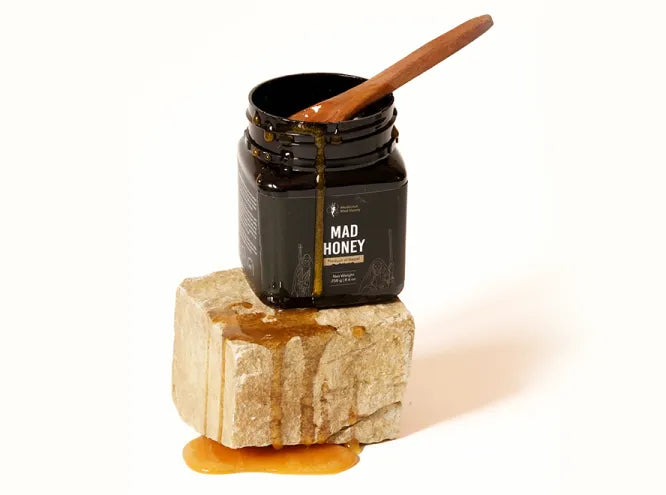Besides Turkey, the Himalayas of Nepal are considered as the sacred place for the origin of mad honey. The high cliffs of Himalayas from where mad honey is harvested and the Mad Honey have an inseparable connection and a shared love.
Capturing the curiosity, these Himalayas has always allured a lot of adventure seekers, Enthusiasts, travelers and adventurers in search of unique and unconventional experiences. Besides trekking, mountaineering and sight seeing Himalayas of Nepal is famous for another product known to the world as a hallucinogenic sweet elixir known as Himalayan Mad Honey.
The unique experience of Honey Harvesting from the cliffs by the Gurungs, aka the Honey Hunters of the Himalayas in traditional ways is thrilling to watch. Also, tasting the wilderness straight from the Hive can be a equal opportunity one can have.
Hallucinogenic Honey from the Himalayas
The world’s largest species of honeybees known as the Giant Himalayan Bees prefers to live in the cold Himalayan climate. Because they prefer the cold climate of the Himalayas of Nepal they collect nectar from whatever is available in the high altitude regions of Nepal. The high altitude regions of Nepal have less flowering plants but special kinds of plants known as rhododendron which are found in abundance. The Giant bees then collect nectar from flowers available such as Rhododendron and some wildflowers. The nectar which later get processed by the bees is harvested as Himalayan Mad Honey. The harvested honey does contain Grayanotoxin which shows hallucinogenic effects when ingested in higher doses.
The high altitude, weather, and surroundings in the Himalayas support the growth of rhododendron plants that make nectar. The mountains and remote villages in the Himalayas have also played a role in keeping the traditional honey collection methods alive, ensuring that mad honey harvesting by traditional equipment process lives on!
This mystic nectar holds a dear place in the Himalayan communities. For centuries, these communities have celebrated the psychoactive and medicinal properties of Grayanotoxin rich bee nectar. Also, they have tried its magical properties themselves, so they also vouch for the wonders it can do for health.
Mad Honey in Himalayan Culture
In some cultures, this hallucinogenic liquid gold has been used in traditional rituals and religious ceremonies and is believed to make you more aligned with yourself. Basically, they also find that mad honey is an impeccable fluid to grow your spiritual health.
Consumed in controlled quantities, the locals say that it facilitates transcendent experiences and enhances meditation, enabling practitioners to attain deeper levels of awareness and spiritual insight.
In some Himalayan cultures, it is offered as an offering to deities, symbolizing a connection between the natural world and the realm of the divine. They believe that Its consumption during religious festivals and rites promotes a profound sense of unity with the universe.
Read: Health Benefits of Mad Honey
Himalayan Honey Usage
The consumption of this mystic nectar also has a link to traditional healing practices. In certain Himalayan cultures, bee syrup is considered to have therapeutic qualities, such as treating gastrointestinal issues and respiratory ailments. But it does have some dosage guidelines which shows side effects of Himalayan Mad Honey when overdosed.
Furthermore, mad honey has also found its way into culinary practices, adding a unique flavor to dishes and beverages. The distinctive taste of mad honey, along with its potential effects, makes it the most sought-after condiment in cooking.
In recent times, the growing interest in natural remedies, cultural heritage, and unique culinary experiences has sparked renewed attention toward Grayanotoxin-rich bee nectar.

Sustainable Honey Harvesting in the Himalaya
The honey hunters from the Gurung community reside in the Himalayan region of Nepal. They carry their traditional honey hunting knowledge, passed down over generations, graciously. Because they aim to balance mad honey production with cautiously preserving the ecosystem.
These honey hunters have a strong determination to avoid excessive harvesting from a single area and embrace sustainability. Also, they are well-known for the rhododendron flowering cycles, so they can collect the best of the best mad honey.
They use gentle extraction techniques that minimize disturbance to hives and nearby plants. This sustainable approach for beekeeping not only ensures a continuous supply of this hallucinogenic liquid gold but also protects the delicate Himalayan ecosystem for generations to come.
Honey Harvesting in the Himalayas
Mad honey hunters set out on daring journeys that lead them to vertigo-inducing cliffs where the giant bees reside. Armed with basic ropes, handmade ladders, and unwavering determination, these courageous individuals go on to collect the mad honey.
Upon their arrival, they are welcomed with stinging bites from the bees, which they try to ignore. Hunters often employ smoke or other natural remedies to calm the bees and temporarily ward off their attacks.
Even with these measures, the risk of multiple stings and potential allergic reactions is a constant threat. The climb itself is a daunting challenge. Hunters must navigate cautiously along narrow ledges, rocky formations and steep slopes. Although they constantly worry about any misstep, they don’t stop there.
The unpredictable and rapidly changing weather conditions of mountainous regions add an additional layer of danger to the already difficult pursuit of Mad Honey.
What may start as a routine hunt under clear skies can quickly transform into a life-threatening test as weather patterns shift with little warning. Thick fog, sudden rainstorms, and changing temperatures can turn a relatively straightforward expedition into a fight for survival.
Is Mad Honey Different from Himalayan Honey?
If you ever think about how much honey is different from its counterpart Himalayan Honey, you might say, “After all, they both come from the Himalayas?”
Well, fasten your seatbelt! Mad honey is way more powerful than Himalayan honey. It has double the effect of what usual bee nectar stimulates. But if you find a label saying Himalayan Mad Honey from Nepal, consider it as potent equal worth of Mad Honey.
Also read: Can I use Himalayan Mad Honey and Himalayan Pink Salt before workout?
Few companies are labelling regular honey under the name of Himalayan Honey just because they come from the Himalayas and it gives unique selling point to the brands. This often confuse buyers with the Mad Honey Product, some buy product like these without much analysis and write on their feed, "Buying Mad Honey is not worth it". So, it is always advised to check the label for Grayanotoxins before buying. If it contains Grayanotoxin it is indeed Mad Honey but still, it is necessary to find and choose authentic mad honey product.
Bottom Line
As ancient traditions meet modern exploration and curiosity, the importance of mad honey in Himalayan communities keeps evolving. This exploration leads to a greater understanding of the intricate connection between nature and culture.
You cannot mention mad honey without mentioning the beautiful landscapes of the Himalayas. It won’t be wrong to say that the unusual potency of mad honey comes from the unique climate of the mountains. Last but not least, don't forget, How much mad honey can you take?






